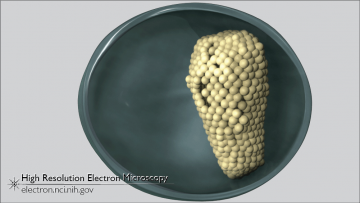Before reaching their mature, fully infectious form, HIV virus particles transition through an immature, non-infectious state. In the non-infectious form, the inside of the virus particle is lined with a lattice of Gag proteins. During the virus’ transition from the immature state to the fully infectious state, a piece of the Gag protein (the capsid) is cleaved off. The capsid piece goes on to form the cone-shaped HIV core, which encloses the virus’ genetic material.
There are several theories about how capsid proteins come together to form the core. One popular theory, the “nucleation and growth model,” states that after the capsid proteins are cleaved off the Gag protein, they drift into the center of the virion, then “nucleate” at what will eventually become the narrow end of the core, and coalesce into the core’s mature lattice structure.
In a study published in 2015, we visualized HIV virions at high resolution using cryo-electron tomography. Surprisingly, instead of finding cores growing from one end, we saw sheets of capsid material curling off the inside of the membrane, wrapping around to form a cone shape. That led us to propose a new model for core formation, where a pre-existing lattice of capsid protein undergoes a “non-diffusional phase transition” as it shifts from the immature to mature lattice structure. This transition causes the lattice to curl into the core shape, leaving tell-tale cracks and fissures in the mature lattice, which we could confirm in our tomographic data.
The image above is an artist’s representation of a core within an HIV virus particle, with irregularities in the core’s capsid lattice. An animation of our proposed core formation process is also available below.
Full-size image: Download (0.3MB) | View animation | Download animation composite image (0.9MB)
Related Reference: Frank GA, Narayan K, et al. Maturation of the HIV-1 core by a non-diffusional phase transition. Nat Commun. 2015 Jan 8;6:5854. doi: 10.1038/ncomms6854.
